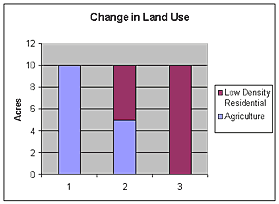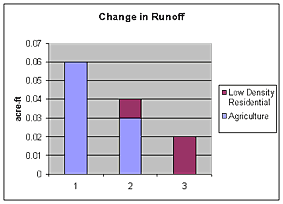|

Interpreting L-THIA's Results: Agricultural to Low Density Residential
Ten acres of agricultural
land on Hydrologic Soil Group A is changed in two
stages to low density residential (see graph below).
The total runoff generated by this change in land
use in the watershed actually decreases (see graph
below).

This reduction
in runoff is due to the fact that, though a land
use such as agriculture has considerably less
built-up and impervious surface than low-density
residential land use, the type of drainage used
in the fields (e.g., tile drains) and the
drainage patterns artificially established due
to ploughing patterns actually result in greater
amounts of runoff. The straight
lines made on the fields during ploughing increase runoff by acting
as channels into which water easily flows.

Low-density residential
areas, on the other hand, have large open spaces
around them that are covered with grass and trees
that effectively act like pastures and forest
in terms of reducing runoff. As a result, low density
residential areas produce less runoff that an
equal area of agricultural land.
|